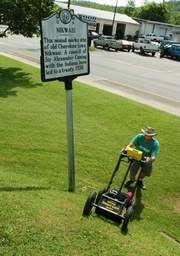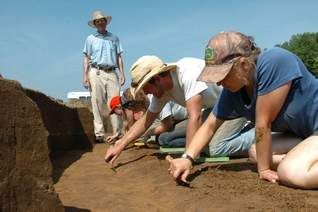(But I guess that Native Graves don't matter long as they get what the rich man wants)
Archaeologists unravel WNC's ancient secrets
June 28, 2009
http://www.citizen-times.com/apps/pbcs.dll/article?AID=/20090628/NEWS01/906280346

Western Carolina University geologist Blair Tormey uses ground penetrating radar to study the Nikwasi Mound in Franklin. The mound is believed to be the spiritual, political, and physical center of the Cherokee town of Nikwasi. (John Fletcher/Jfletcher@citizen-times.com)
Warren Wilson professor, David Moore watches as Abra Johgart, from left, Allyson Gardner, Travis Williams, and Emma Richardson work alongside archeologists, students, and volunteers to help excavate what is believed to be a Spanish compound, Fort San Juan, built in 1567 near what is now Morganton.. (John Fletcher/Jfletcher@citizen-times.com)
Archeologists, students, and volunteers sift through their findings as they excavate what is believed to be a sixteenth-century Spanish compound, Fort San Juan, near what is now Morganton. (John Fletcher/Jfletcher@citizen-times.com)
FRANKLIN — Plastic bags packed with pottery shards fill 5-gallon buckets inside a metal storage container a few hundred yards from the edge of the Macon County Airport runway.
Airplanes throttle for takeoff as archaeologists sift through the remains of an ancient village.
The excavation is North Carolina's largest right now, and it's a fitting example of the friction between accommodating development and protecting history in a growing state with uncharted archaeological value.
Work on the 6-acre site is being done so the airport can extend its runway. The archaeological study is required before construction because government money will be used in the work.
"It is really unusual to get a look at this much area," said lead archaeologist Tasha Benyshek of contractor TRC Solutions. "It tells you a whole lot more about the settlement."
More exploration could be coming to North Carolina, thanks to road-building dollars from the federal economic stimulus plan. But archaeologists say more needs to be done to preserve private land where development threatens to destroy potentially important sites.
Archaeological study is not required on private land unless a grave is discovered.
Pace of development
As one of the nation's top states for population growth, North Carolina stands to lose 2 million acres of crops and forest land to development by 2027, according to conservation advocate Environment North Carolina.
"I don't think we are doing enough to preserve the evidence we need to study slowly," said Thomas R. Whyte, a professor of archaeology at Appalachian State University. "Maybe our efforts should be more toward conservation for future archaeologists rather than sending out the armies to do more research."
The N.C. Office of State Archaeology in Asheville is putting together a list of important studied and unstudied Cherokee town sites in Western North Carolina with the hope of partnering with land trusts on conservation. The list could be competed this year.
In the meantime, private groups and universities continue to uncover the ancient secrets of WNC.
Berry site
In Burke County, archaeologist and students are in their eighth year of unearthing the earliest known European settlement in the interior U.S.
Warren Wilson College started the excavation of the Spanish Fort San Juan under the direction of David Moore, professor of sociology and anthropology.
"The remains here are absolutely unique," he said. "This is a fascinating site. It is well-preserved, and this is the only one of the early forts that has ever been identified."
This summer's four-week field school is made up of 40 people from Warren Wilson and other colleges in the region.
Capt. Juan Pardo's men built the fort in 1567 near the native town of Joara while looking for an overland route to Mexico..
Excavations have uncovered the remains of five burned structures that Moore said he believes are the remains of the fort compound.
Archaeologists on the 12-acre site north of Morganton have also found Spanish pottery, nails, lead balls, copper, fragments of iron and Spanish chain mail armor.
"What we hope to learn is more about the everyday interactions between the Indians and the Spanish and see if there are any clues as to how things might have changed at this village with the Spanish living there," Moore said.
North of the Burke County site, another field school is looking at how life changed for native people after a dramatic event.
New River site
Researchers in Ashe County recently wrapped up four weeks of study at a prehistoric site along the New River, on a terrace along the river's south fork.
Whyte, the ASU archaeologist, held his summer field school there.
It has yielded evidence of human activity dating to 12,000 years ago on up to more modern times.
Students found stone tools normally associated with Paleo-Indian sites, Whyte said.
He was invited to study the 2-acre site by the landowner. The ground has been farmed for years. Whyte expects to spend at least two more summers there. The work is funded by the university and, like the Berry site, relies on students.
He hopes to compare what he learns at the New River site with his work on the upper Watauga River.
Whyte is particularly interested in how climate change affected settlement patterns in the region.
In the upper Watauga River area, he found the little ice age, which started around 1300 and ended at the start of the Industrial Revolution, forced people off land 2,500 feet above sea level and higher. His theory is the cold climate made growing crops unpredictable.
A few hours to the west, a very different type of dig is going on this year, but it, too, is yielding surprising new details about how early people lived in WNC.
Macon Airport
Native people lived on the land that is now the airport just outside Franklin during at least four distinct time periods: 600, 1200, 1600 and in the 18th century, when the location was part of the Cherokee town of Iotla visited by naturalist William Bartram.
The excavation started this spring on the 6-acre site, and so far it has yielded important information about the prehistoric and early historic people who lived there..
Archaeologists with TRC found post holes they said they believe are two palisade fence lines that would have surrounded small villages in AD 1200.
The Early Mississippian time period is important because very little is known about it in WNC. The archaeologists didn't expect to find people were building fortified villages in the area at that time
"It wasn't necessarily the settlement pattern," said lead archaeologist Benyshek.
She said conflict among rival groups could have caused the people living in the Iotla Valley to build the fortification.
The size of the site, which is the largest dig going on now in the region, is also going to be important because it is rare to uncover so much area, Benyshek said.
About a dozen archaeologists are working on the site.
The N.C. Department of Transportation's Aviation Division is spending $535,000 on the initial work, which is scheduled to be completed by September.
Just down the road from the airport, a different approach to learning about ancient people is focusing on a well-known landmark.
Nikwasi Mound
No one has ever excavated the 30-foot-tall Nikwasi Mound in downtown Franklin, and no one will. It is permanently protected.
So researchers are using a ground-penetrating radar machine in a project organized by the nonprofit Native American Cultural Sites Preservation Project to get some idea of what is in inside.
The work, like most archaeology projects in the region, is a partnership, organizer Bill Evans said.
He credits the town of Franklin, which owns the mound, and Western Carolina University, which owns the machine, for making the survey possible.
The Cherokee Preservation Foundation, the Land Trust for the Little Tennessee and Cherokee Tribal Historic Preservation Office have all been involved through funding and support.
Anne Rogers, WCU professor of anthropology who is involved in work with the radar machine, said the mound, more than 1,000 years old, was the site of the council house in an ancient Cherokee town. "This was a very important place in the past," she said.
The data from the cart is entered into a computer at the university to create an image of the mound and features inside. So far, researchers have learned the mound is larger than it appears. Sediment over the years has obscured its sides.
Learning exactly what is more complex.
The effort is one that archaeologists point to as a reason to preserve important sites for future study instead of excavating everything now.
Organizers hope to use the Nikwasi Mound as a test piece to refine the noninvasive method for use at other potentially important sites.
"Archaeology is by its nature destructive," said Dolores Hall, deputy state archaeologist.
The state typically calls for archaeology work on about 10 percent of the projects it reviews each year. Last year it reviewed 2,340 construction projects to determine whether they would affect important sites.
Land conservation and partnerships, like the one between the Land Trust for the Little Tennessee and the Eastern Band in 2007 that protected the Cowee Mound north of Franklin, are good ways to protect the state's archaeological resources.








No comments:
Post a Comment
Note: Only a member of this blog may post a comment.